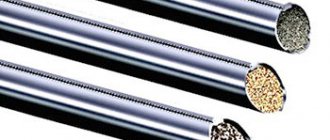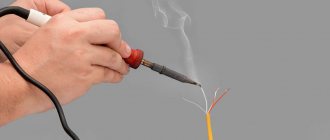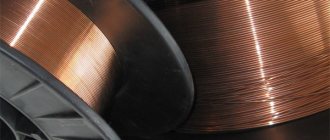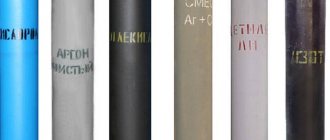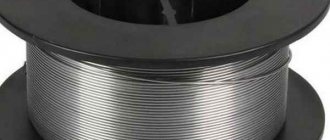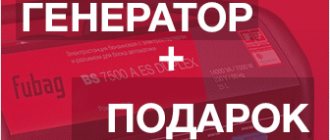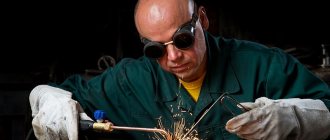In the modern world, there is not a single industrial enterprise that does not use electric arc welding in its production activities. Thanks to this factor, the domestic market for semi-automatic devices is constantly growing and actively developing.
Today it is represented by a wide range of technical means, specific devices and consumables, the most popular of which is welding wire for semi-automatic machines. This important component must match its characteristics as closely as possible to the properties of the metal from which the parts being connected are made. Therefore, a large number of filler products have been developed that are most suitable for a certain type of work.
Types of wire
Welding wire is an indispensable element for successful work operations in various industries and utilities. With its help, several metal segments are connected into a solid structure.
The features of this filler material include ease of use and excellent quality of work performed. Proper selection of wire not only improves the reliability of the weld, but also significantly increases productivity.
Wire for semi-automatic machines is usually supplied in coils, coils and coils. The weight of the first type of packaging sometimes reaches 1.3 tons. The weight of the second type of container can vary from 15 to 120 kilograms. The mass indicators of the third form of packaging range from 5 to 18 kilograms.
Often the wire is placed in boxes or plastic bags. If the product does not have packaging, then before use the wire is dried at a temperature of 200°C.
Powder
This wire is a hollow object made of metal, the free space of which is filled with powder and flux.
These materials help protect the seam from exposure to oxygen and harmful substances formed during the welding process. An important factor here is also ensuring the safety of the respiratory system of the specialist performing technological work.
The use of special additives in welding wire facilitates ignition of the arc and helps reduce metal spattering, which has the most favorable effect on the formation of a high-quality seam. The arc burns in a flux medium, which allows you to protect the area of the welded area from the negative influence of the environment.
For work using flux-cored wire, heavy gas cylinders are not required, which are associated with many hassles: storage, refilling and possible leakage.
Copper-plated
Copper-plated wire is a product designed to work with carbon and low-carbon steels. It is coated with a special copper compound and is used for welding objects in a protective gas environment.
Types of aluminum wire and rules for its use
Aluminum welding wire for semi-automatic machines consists of individual rods or coils of a certain diameter. In any case, they are hermetically sealed. The first feature of using this material is connected with this.
- Electrodes for working on aluminum are not recommended for use when carrying out important work that requires high quality. They are suitable not for industrial purposes, but for home and household purposes.
The fact is that aluminum under normal conditions is covered with a durable and elastic oxide film. Its melting point is about 2500º C. At the same time, the melting of pure aluminum is not higher than 600º C. For alloys the situation is not much different.
- To effectively clean and degrease aluminum and its alloys, it is recommended to supplement mechanical cleaning with the use of chemicals (for example, white spirit, acetone or a special hot alkaline bath)
A consequence of this feature of aluminum and its alloys is the need to first remove the oxide film from the surface of the parts being joined (for example, with a mechanical or hand tool). The electrode itself must be initially free of oxide.
- If the package of electrodes is not completely used up, it must be sealed again with silica gel added inside to absorb moisture.
Aluminum wire for semi-automatic machines
When choosing a wire for welding aluminum alloys, you need to consider what qualities are required from the future weld:
- Seam tensile strength.
- Plasticity of the connection.
- Corrosion resistance.
- Resistant to cracking from heat.
- The diameter of the aluminum wire for semi-automatic welding without gas should be 0.3-0.5 mm greater than the thickness of the parts it welds
It is most convenient to use the table below.
When using welding electrodes, you need to remember the need for their preliminary preparation. In a special purchased or home-made oven, preliminary uniform heating of the electrodes and their so-called roasting are carried out. This will allow you to form a very high-quality seam.
- Aluminum does not change its color when heated, unlike many other metals, so you need to be especially careful when working with it - it’s easy to burn through
In addition to preliminary preparation of the electrodes, you always need to prepare the parts to be connected. They need to be heated evenly in advance. And ensure that this uniform heating is maintained throughout the formation of the seam.
- An alkaline bath is the most effective way to comprehensively remove oxide films and degrease aluminum parts. To do this, you need to make a special solution of 2 liters of pure water, 100 g of trisodium phosphate, 100 g of soda and 50 g of liquid glass. The solution must be heated to a temperature of 60-70º C
It is also necessary to take into account that aluminum tends to cool unevenly and, as a result, crack. Of course, this is compensated by the plasticity of this metal. But if the welds are placed too close to each other (about 10-15 mm ), then cracks will certainly appear.
- Molten aluminum and its alloys are very fluid. That is why all seams are made in one layer in one pass. Where possible, it is recommended to use molten metal containment liners
Marking
The basic requirements regulating all issues of production of wire for welding work are presented by GOST 2246-70 . Today, about 80 varieties of this type of product are manufactured. And in order to understand what a particular type of product is, it is assigned a certain label, which helps to understand the composition of the product and its characteristics. A good example is the popular welding wire sv08g2s .
Its decoding is represented by the following values:
- The combination of the letters “st” indicates that this product refers to welding wire;
- The combination of numbers “08” indicates the amount of carbon (in hundredths) contained in the product;
- The letter “g” emphasizes the presence of manganese in the wire;
- The number “2” is the volume of manganese in the element;
- The letter “c” indicates the presence of silicon in the wire, but if there is no number after the letter designation, this means that the product contains less than 1%, but more than 0.5%.
Based on the markings stated above, we can say that the presented product is an alloyed low-carbon wire, which contains additives such as silicon and manganese.
Semi-automatic welding with flux-cored wire without gas
Typical aluminum welding method. The flux-cored wire is brought by a support to the electric arc and, when burned, evenly covers the weld pool.
This method has a number of positive characteristics:
- has shown excellent quality and functionality for many years;
- relative cheapness and ease of use;
- environmental friendliness and harmlessness;
- excellent functional performance.
The welding work log is a special technical document that allows you to monitor the implementation of welding work, their quality, time of work, etc. See details about the features of filling out the welding work log.
A general article on welding production can be read here.
The diameter of the wire
Wire for semi-automatic devices comes in the following diameters:
- 0.6 mm;
- 0.8 mm;
- 1.0 mm;
- 1.2 mm;
- 1.6 mm.
Such dimensional indicators allow us to fully satisfy the needs of professional welders. For highly specialized purposes, products with a diameter from 3.0 to 6.0 millimeters are perfect.
The required wire size is selected in accordance with the characteristics of the welding current and the thickness of the elements being connected.
Technology
So, you will not achieve the effect of the filler material without using gas; in this case, you need a wire “filled” with flux. The technique of such soldering is simple, similar to conventional manual electric arc welding.
But there are also differences between them. What rules of technology do you need to know so as not to aggravate the situation?
The device must be powered by direct current with reverse polarity. Switching between types of current (AC/DC) is also suitable. Manufacturers create cored wire that is specifically suitable for working with direct current.
But there are also those who make AC wire, and you can buy it if you need it. But there are few brands of such material, so it is difficult to find, and the spattering of metal in this case will increase.
Popular brands
The most popular brands of welding wire presented on the domestic market are:
- Sv-08GSMT. This type of product belongs to copper materials and is used in welding operations using automatic and semi-automatic machines. The wire works well with carbon metals and alloys that contain a low percentage of alloying components. It is characterized by a high level of resistance to tensile loads. This parameter is in the range of 1000-1300 MPa. This grade of wire is widely used for joining thin-walled parts operating under high pressure. Welding is carried out in an environment of protective gases (argon and carbon dioxide);
- Sv-06Х19Н9Т. This grade of wire is intended for working with stainless steel in a protective gas environment. Thanks to the content of elements such as chromium, manganese and nickel, it has good corrosion resistance. Used in the production of food industry products;
- PP2DS. This is a representative of cored wire. This brand allows operations to be carried out in strong winds, which gas shielded welding cannot do. The wire is intended for connecting parts made of steel (carbon and low-alloy), cast iron and non-ferrous metals. Used in shipbuilding and oil industry;
- OK Autrod 19.40 . This wire is from a foreign manufacturer ESAB. It is used for working with rolled aluminum bronzes and for surfacing anti-corrosion layers on metal parts. Its yield strength is 175 MPa, and its strength reaches 400 MPa. Welding operations are carried out in pure argon. This product is used in the chemical industry and automotive industry.
Preparing for work
One of the features of welding without gas supply is the reverse polarity of the current source. When setting the wire feed, you must make sure that the diameter of the feed socket in the feed roller matches the diameter of the wire. The pressure roller does not need to be tightly tightened, since the soft shell may become wrinkled; to prevent this from happening, when feeding, the torch tip must be screwed to the body only after the end of the wire rod appears from the channel hole. Only after this should the tip be installed. There is no need to adjust the nozzle as there will be no gas supply through it during operation.
Preparing metals for welding in CO2
Semi-automatic welding with carbon dioxide allows you to weld metals of any thickness.
Classification of manual arc welding in shielding gas.
The subtleties of preparing products for cooking depend on the thickness of the metal:
- Thin metal sheets up to 1 millimeter are welded using edge flanging. The absence of such processing is allowed, but in this case the gap between the welded surfaces should not be more than 0.5 millimeters.
- Sheets with a thickness of 1 to 8 millimeters can be welded without cutting edges. The maximum allowable gap is 1 millimeter.
- Thicker metal, up to 12 millimeters thick, requires additional processing in the form of a V-shaped cutting.
- Products with a thickness of over 12 millimeters are recommended to be welded after performing an X-shaped cut.
Before performing work directly, products must undergo the following procedures:
- Complete cleaning of welded edges. Removal of dirt and scale can be done using a shot blasting or sandblasting unit. If there are none, you can clean the surfaces with simple sandpaper.
- Sticking surfaces. Preliminary welding in several places is carried out using electrodes E42 or E42A.
